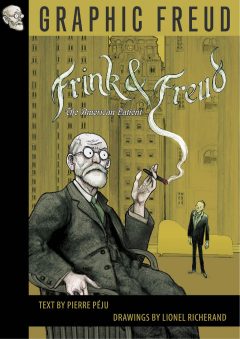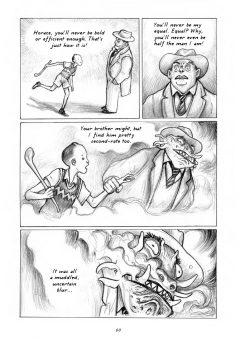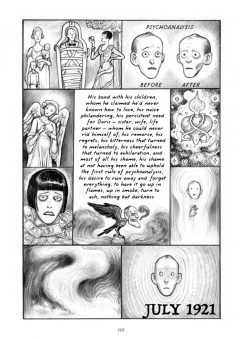Review: Frink and Freud: The American Patient (SelfMadeHero)
We’ve all heard of Sigmund Freud: the founding father of psychoanalysis, interpreter of dreams, creator of the theories of repression and the Freudian slip. But we’ve heard very little about one of his earliest disciples, Howard Frink. In ‘Frink and Freud: The American Patient’, writer Pierre Pèju and artist Lionel Richerand attempt to amend this, by telling Frink’s bizarre story from beginning to end, and how he inadvertently cast a dark shadow over Freud’s professional career.
 Publisher: SelfMadeHero
Publisher: SelfMadeHero
Writer: Pierre Pèju
Artist: Lionel Richerand
Price: £14.99 from SelfMadeHero
Our story begins in Vienna in 1928, with established professor of psychoanalysis Sigmund Freud mulling over a past relationship with a man named Horace Frink. Freud clearly feels some regret and unease over this relationship, but it is unclear why this is the case. The narrative that follows switches between the present day 1928 Freud, and the Freud of 1909, as we delve further into the story.
Though the graphic novel is named Frink and Freud, aside from the first quarter, the predominant focus is on Frink, his upbringing, and life as an adult. The first section serves as a setting of the scene, before the novel travels back in time to Frink’s childhood. It also allows the reader to reacquaint or acquaint themselves for the first time with some of Freud’s more popular theories, such as the interpretation of dreams. Though this first section moves somewhat slower than the rest of the book (which is more dramatic), it is important in foreshadowing Frink’s descent into what some may call madness.
The main narrative begins when we are transported back in time to Frink’s early childhood. When the story focuses on Frink the drawings are less detailed and more sketch-like, which works well when discussing his early trauma, and lack of understanding. To put it bluntly, Frink’s childhood is terrible. He is continually told by his parents, particularly his father, that he will never amount to anything, whilst they praise his older brother relentlessly. Because of this, Frink begins to suffer with horrifying nightmares, with monsters emerging from every crevice of his room. They almost encompass the entire page at times, with a particularly well-thought-out border depicting a monster’s mouth surrounding the accompanying text and panels. As his family dismisses his ‘delusions’, Frink grows more paranoid, and begins to associate his own parents with the monsters he sees in his dreams.
 The charcoal illustrations throughout do wonders for showing facial expression, particularly distress and sorrow (which, as you can imagine, is a frequent emotion in a book about Freud). We loved the use of shading, and we were particularly fascinated by Frink’s button-like eyes, which reminded us of Coraline (by Neil Gaiman). They served to not only give him a vacant, not-quite-there facial expression, but also to indicate that there is something rather uncanny about him, even as a child.
The charcoal illustrations throughout do wonders for showing facial expression, particularly distress and sorrow (which, as you can imagine, is a frequent emotion in a book about Freud). We loved the use of shading, and we were particularly fascinated by Frink’s button-like eyes, which reminded us of Coraline (by Neil Gaiman). They served to not only give him a vacant, not-quite-there facial expression, but also to indicate that there is something rather uncanny about him, even as a child.
Frink is only able to escape his circumstances when his father’s factory burns down, and he and his family are forced to live with his grandfather, someone who actively encourages him. When his parents desert him to live abroad on their own, things finally seem to be going Frink’s way (aside from his paranoia about fires). He meets a girl named Doris who eventually becomes his wife, gets prodigious grades in school and seems to be generally thriving. But after an unsuccessful stint at becoming a surgeon, Frink starts to become fascinated with Freud, even becoming a psychoanalyst himself.
 So many things occur because of this, the most significant of which is Horace’s affair with his married patient Angelica Bijou. This affair allows Horace to temporarily feel like he’s escaped his mundane life, but this is temporary, and Frink must seek out the help of his hero Freud to decide what to do. These are probably some of the most interesting panels of the book. The back and forth between Frink and Freud is written extremely well, with their contrasting personalities being showcased. They are also framed delightfully illustration-wise, with the information from their sessions being written in the middle of the page, and eight separate panels framing it, all with strange, dream-like interpretations of everything Frink is struggling with.
So many things occur because of this, the most significant of which is Horace’s affair with his married patient Angelica Bijou. This affair allows Horace to temporarily feel like he’s escaped his mundane life, but this is temporary, and Frink must seek out the help of his hero Freud to decide what to do. These are probably some of the most interesting panels of the book. The back and forth between Frink and Freud is written extremely well, with their contrasting personalities being showcased. They are also framed delightfully illustration-wise, with the information from their sessions being written in the middle of the page, and eight separate panels framing it, all with strange, dream-like interpretations of everything Frink is struggling with.
To delve into the narrative any further would mean spoiling it for future readers, but we warn you, the rollercoaster ride of Horace Frink’s life and his fascination with psychiatry is far from over; just when you think it can’t get any more tumultuous, it does. If you’re at all interested in psychoanalysis, we recommend giving this one a read.



September 18, 2025 @ 10:46 pm
Thank you for your sharing. I am worried that I lack creative ideas. It is your article that makes me full of hope. Thank you. But, I have a question, can you help me?
October 9, 2025 @ 10:44 pm
Can you be more specific about the content of your article? After reading it, I still have some doubts. Hope you can help me.